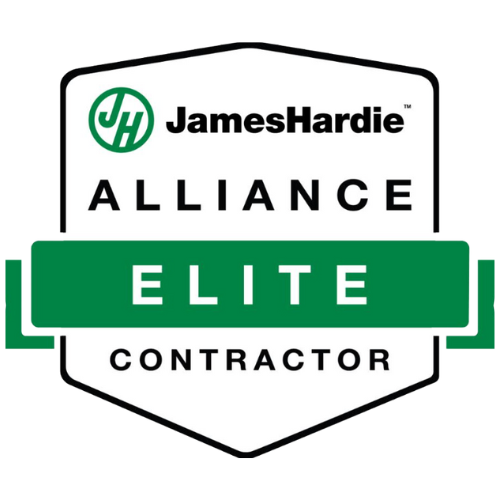Text or Call
Storm Damage Repair
Where do you turn if you want to re-side your home in an environmentally responsible way? James Hardie fiber cement siding has a reliable track record of longevity, durability, and low maintenance compared to its competition: wood, vinyl, and aluminum.
In general, home remodeling can have negative environmental consequences unless you choose sustainable materials with a smaller carbon footprint. Environmental issues like synthetic product production and waste removal of old vinyl siding are at the forefront of the problem.
Learn why fiber cement is a good choice for eco-conscious homeowners who want to be good stewards on a global level.
Sustainable building materials should increase the energy efficiency of your home, and therefore reduce fossil-fuel dependency. Sustainable building practices emphasize the use of recyclable, durable, low-maintenance materials in the building and remodeling of your home.
Siding materials often need to be replaced after 20 years, but fiber cement lasts 30-50 years, making it a sustainable option for environmentally conscious homeowners. Finding a way to replace your siding less frequently is a great sustainable building practice, and James Hardie is the perfect solution.
The single most important factor in green siding is durability. If you want green siding, it’s got to be long-lasting. It must handle water, heat, and UV radiation for years.
Hardie siding has a 30-year warranty, indicating its manufacturer knows it will last. Homeowners who have their fiber cement installed by a James Hardie Preferred Contractor (like us!) and who maintain it well over the years enjoy their siding for 50-plus years! How is that for durability? If you choose this resilient siding, you’ll probably never have to re-side your home again.
The James Hardie company invented fiber cement in the 1980s. It’s made of cement, sand, wood fibers, and water. It is asbestos free and has a non-toxic makeup. While vinyl siding won’t degrade in your local landfill, wood will break down, and fiber cement lasts so long that it will be decades before it even needs to be recycled.
Sustainable siding uses products and materials manufactured locally that travel fewer miles to get to consumers. This results in reduced air pollution and less fuel usage, a lower environmental impact, and an increase in the local economy. With many of James Hardie’s locations scattered throughout the U.S., their products are easy to obtain regionally.
Hardie siding seals your home upon its installation and will safeguard it from damage over its lifetime. Because it doesn’t warp, doesn’t allow water to invade, and won’t invite pests into your home (because it’s not edible), you will enjoy a well-protected home that isn’t compromised or vulnerable to damage. The result of a siding system that remains intact over the years? Cool air will stay indoors each summer, and heated air will stay put each winter, lowering your utilities and increasing your energy savings consistently.
Combine James Hardie siding with a layer of insulation (between your walls and your siding), and your energy savings will increase even more than if just your siding is replaced.
Wood siding requires tedious maintenance. It needs to be sanded and re-stained or repainted every few years—costing you time and money. Hardie siding requires almost no maintenance, giving you more time to do the things you love.
Simply wash your siding every 6-12 months with a garden hose and a medium bristle nylon brush, and it will maintain its beauty over the years! Use a mild soap and water mixture for any stains.
Keep an eye on your siding’s caulking because although siding panels will last 50-plus years, caulking won’t. Replace caulking as needed, and your siding will stay well sealed.
Vinyl siding can emit toxic off-gassing, which can contribute to illness. Off-gassing happens when synthetic materials release volatile organic compounds (VOCs) into the air.
While vinyl, carpeting, air fresheners, and adhesives contain VOCs, fiber cement siding is inert and won’t harm you by off-gassing. VOCs are so harmful that exposure can be linked to kidney and liver problems and cancer. Why not stay away from VOCs by choosing non-toxic siding like fiber cement?
James Hardie is a company of innovative leaders who constantly raise the bar in the siding industry with their research-based engineering of new products and their consideration for the environment. Four ways they impact the environment include:
Hardie makes the use of recyclable resources a priority.
They maximize water recycling within their facilities.
Hardie lessens manufacturing waste significantly.
They safeguard the environment by minimizing their greenhouse gas intensity.
When you choose fiber cement siding for your home’s upgrade, you can do so knowing you’re being good to yourself, your community, and the world. The Hardie company prioritizes the management of waste, water, energy, and emissions.
At American Way Exteriors, we’re the only James Hardie Elite Preferred Contractor in the Dayton area. This means that after thorough training by the manufacturer, we install your siding correctly to ensure you get the high performance it was designed to deliver and to protect your 30-year, transferable, non-prorated warranty.
Take a moment to learn more about our James Hardie siding services.
American Way Exteriors has earned numerous positive reviews for our outstanding service. Read about our customers’ pleasant experiences working with us, then contact us today to learn how we can improve your home with new siding and roofing.








